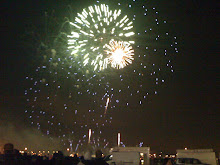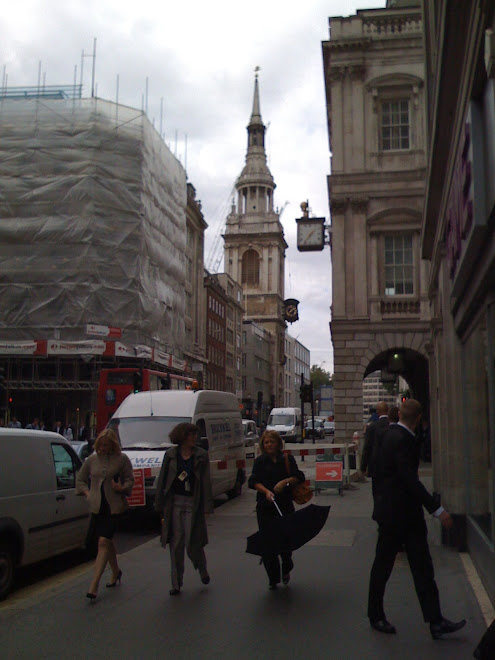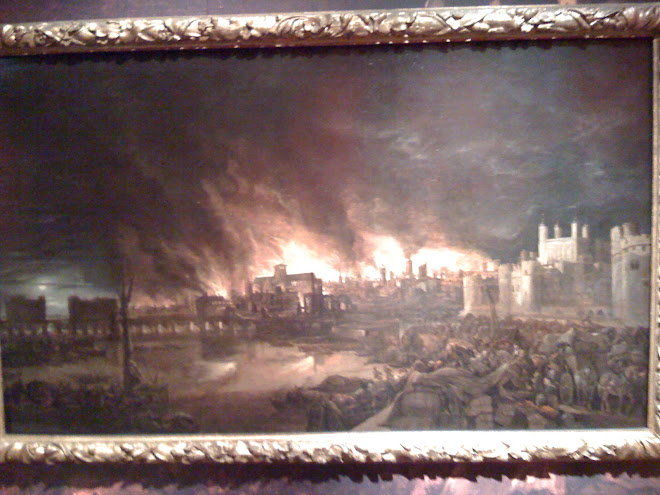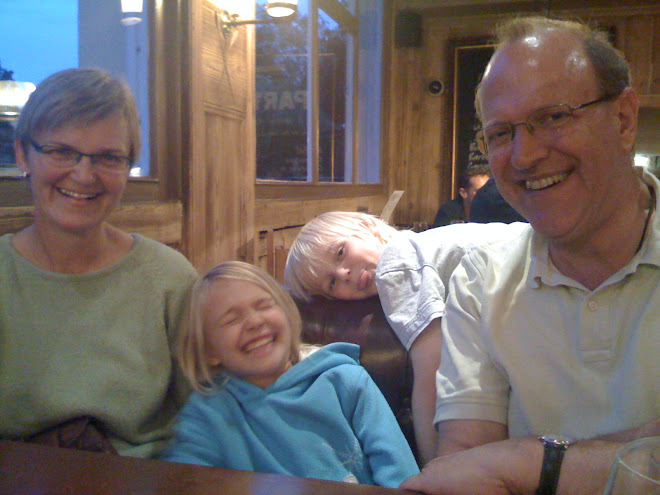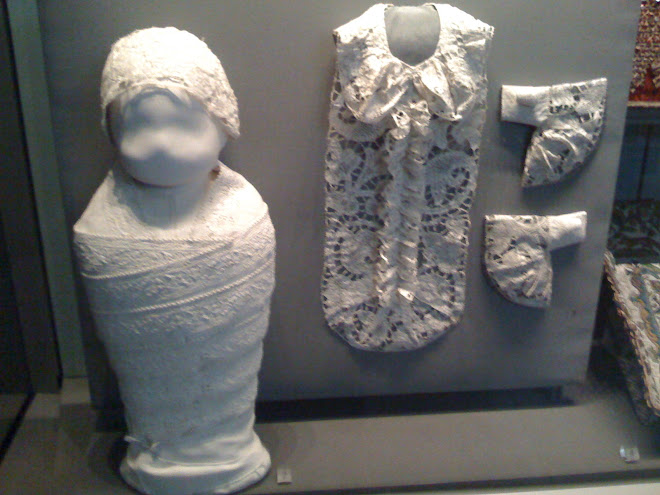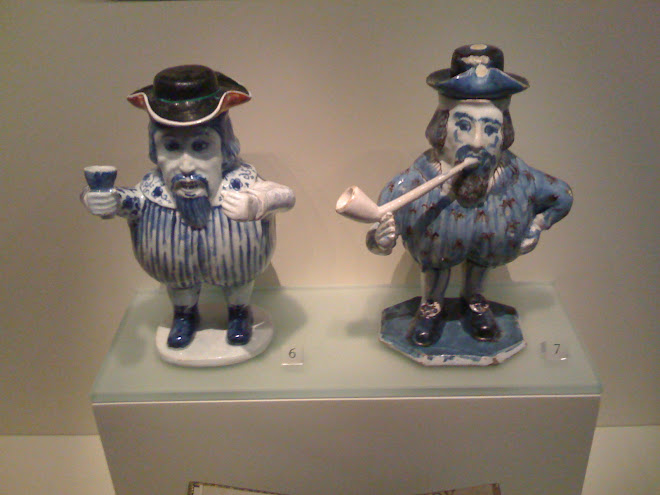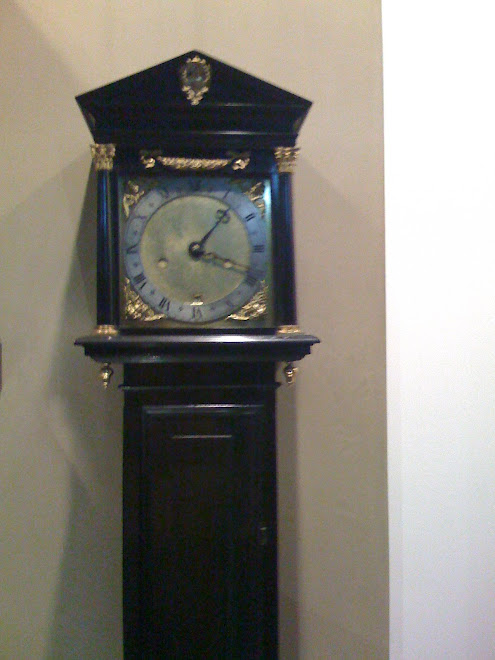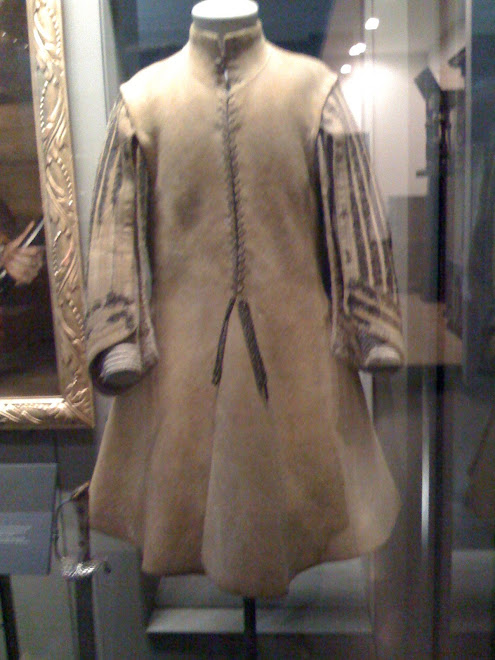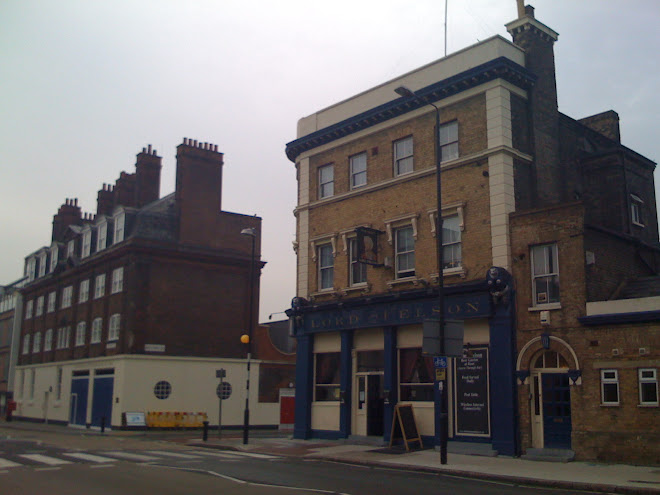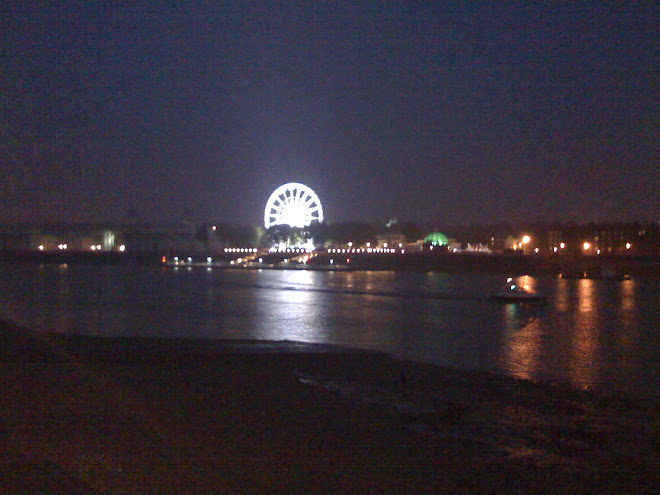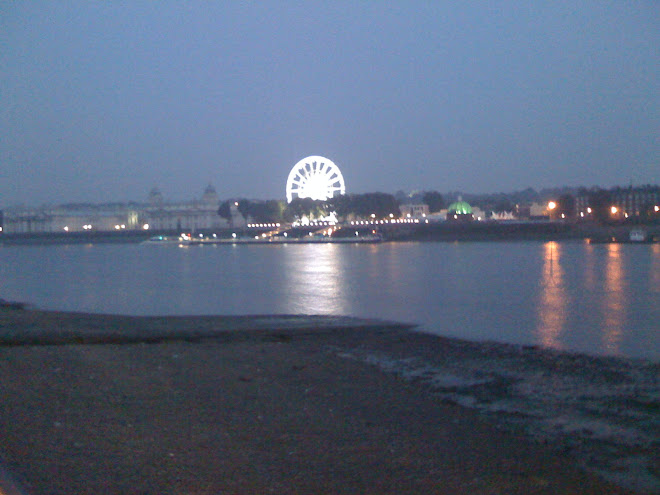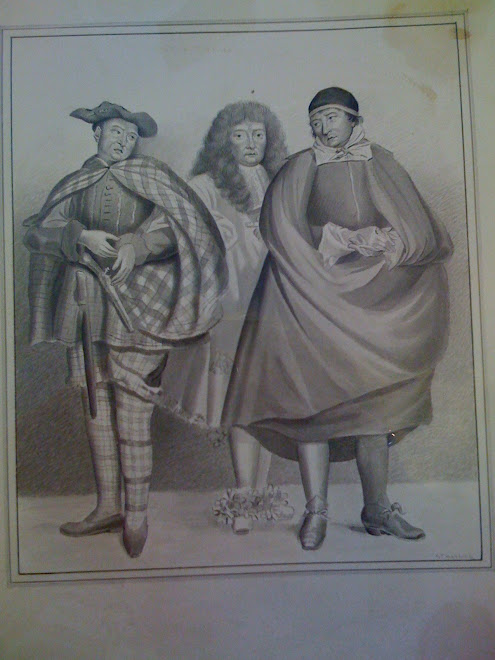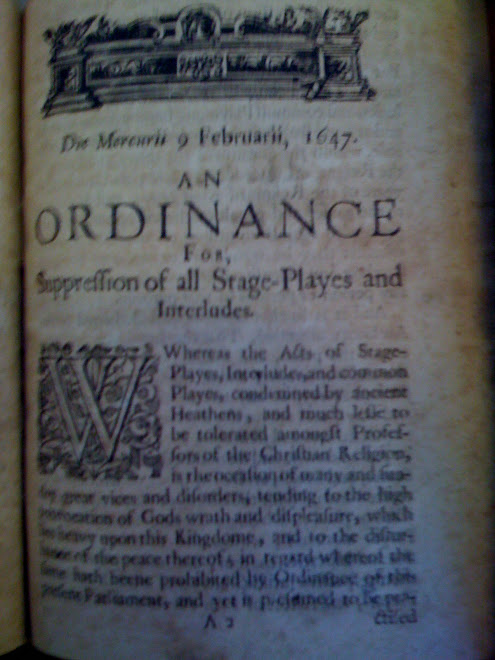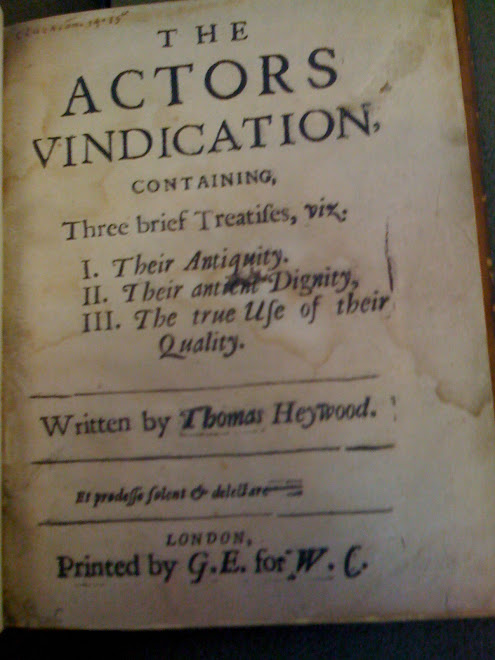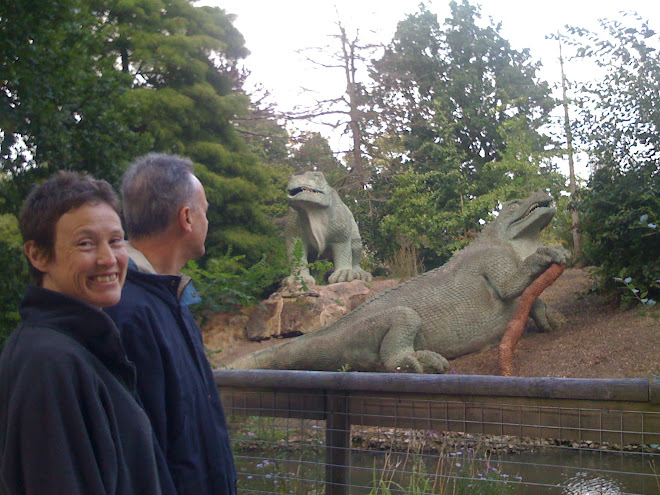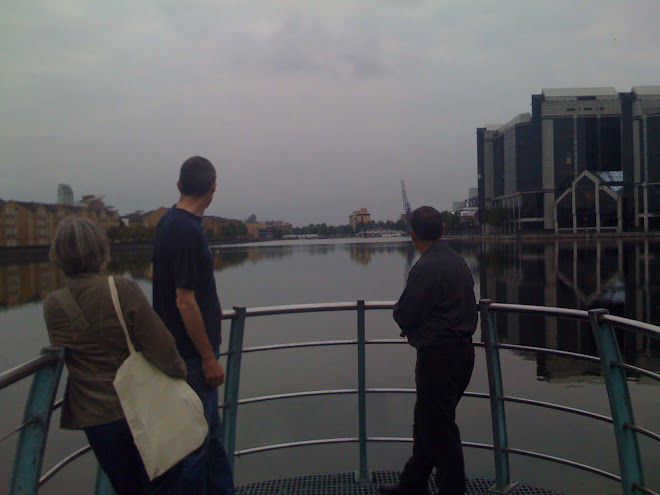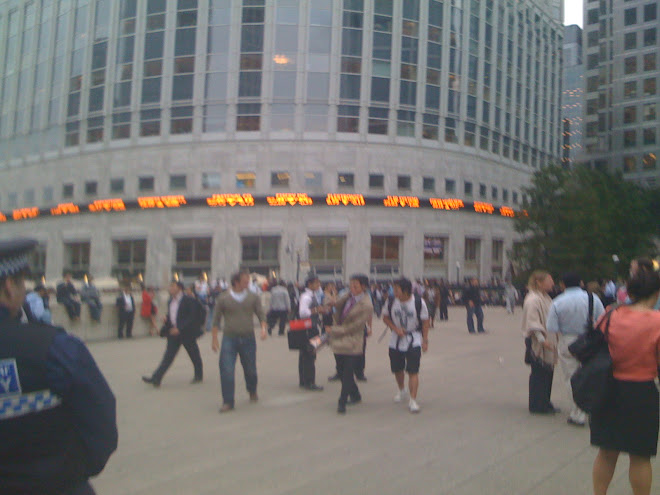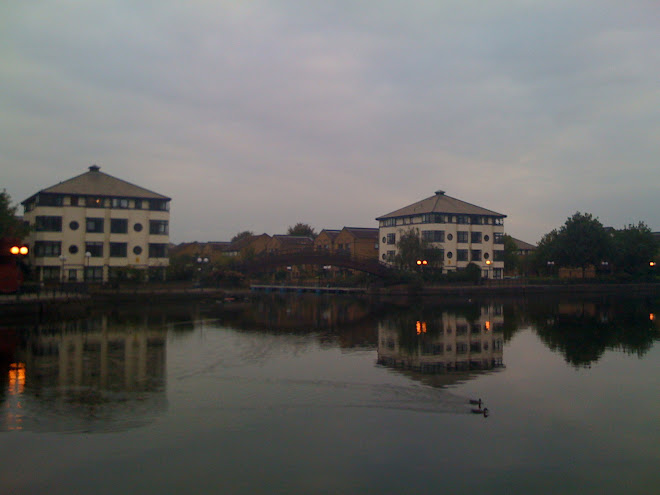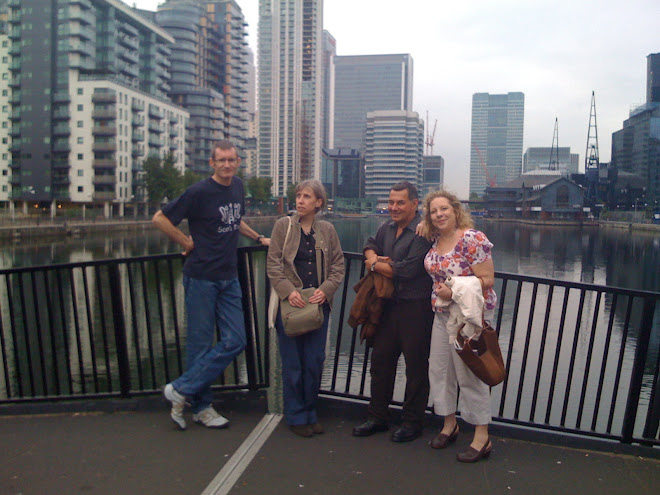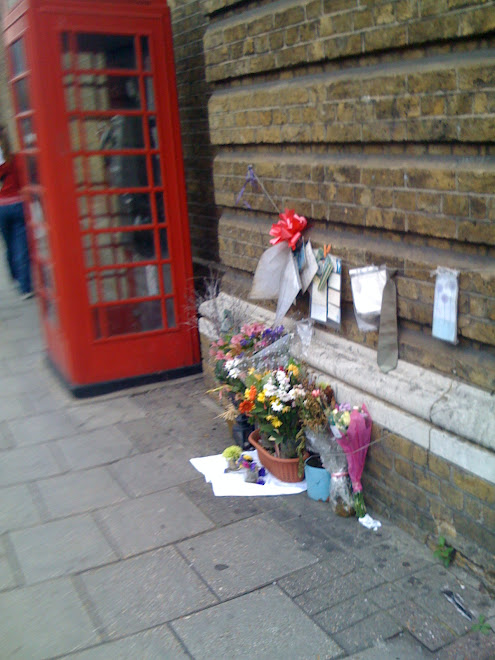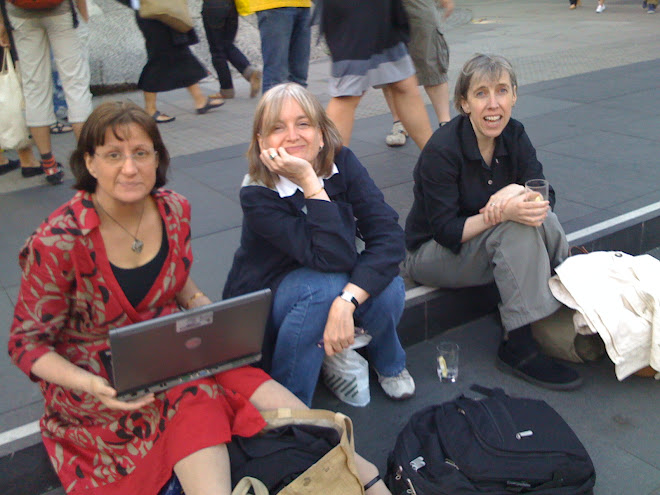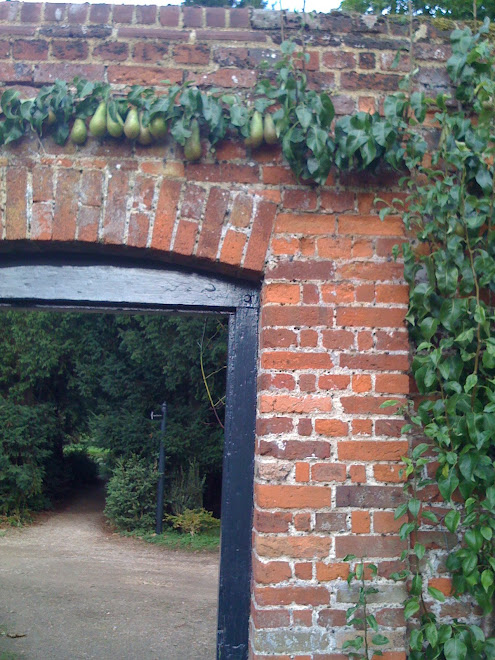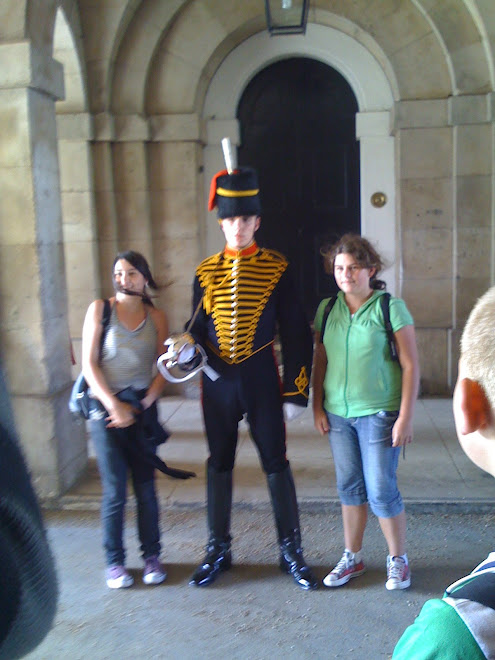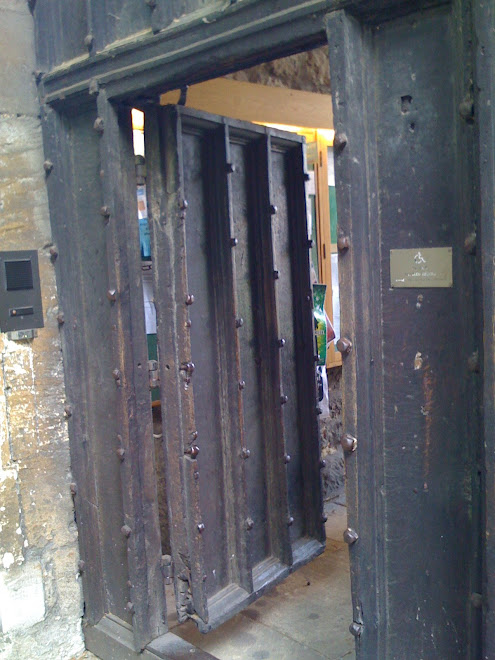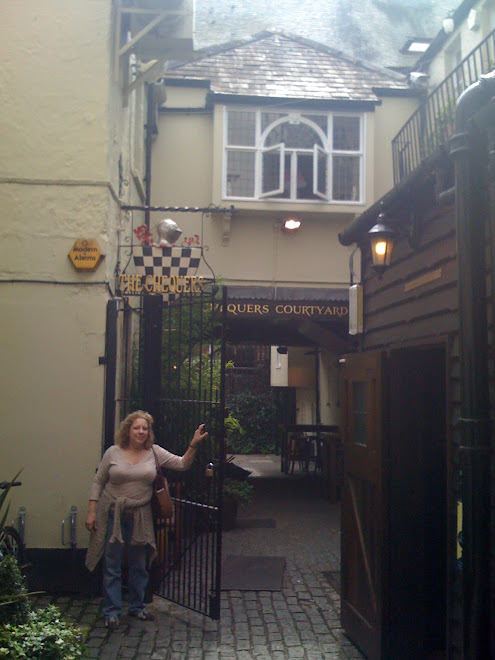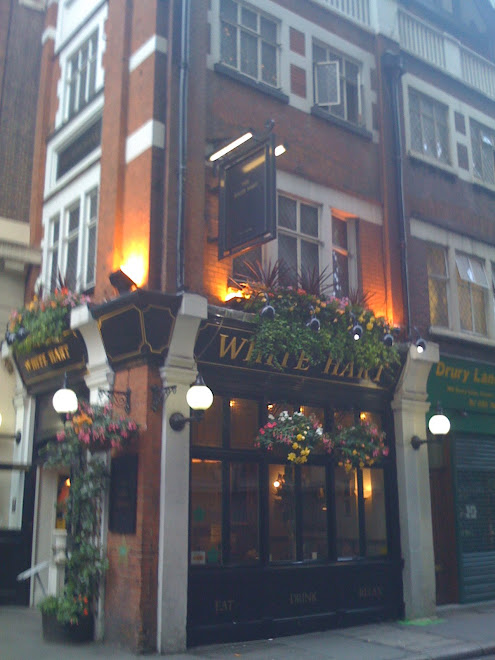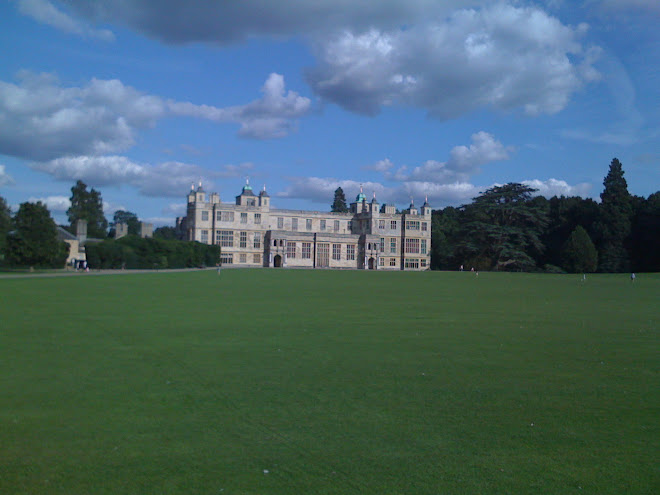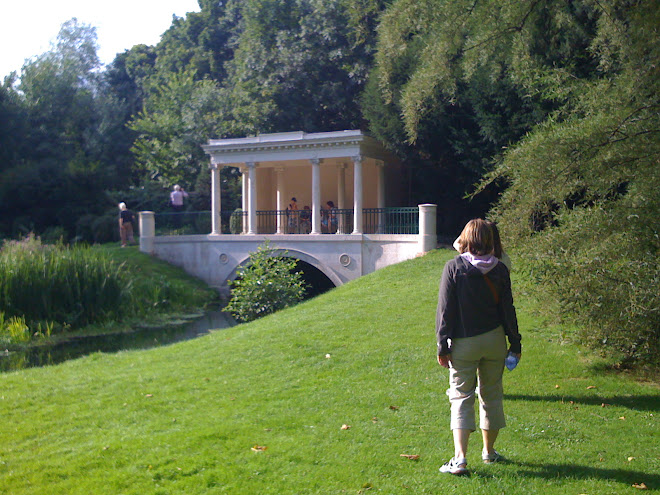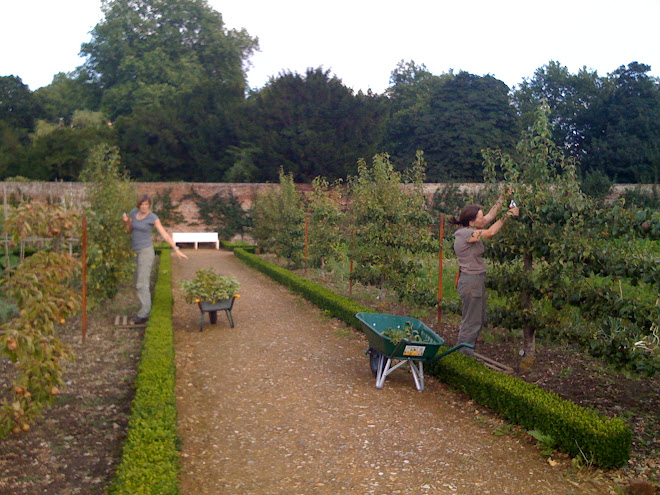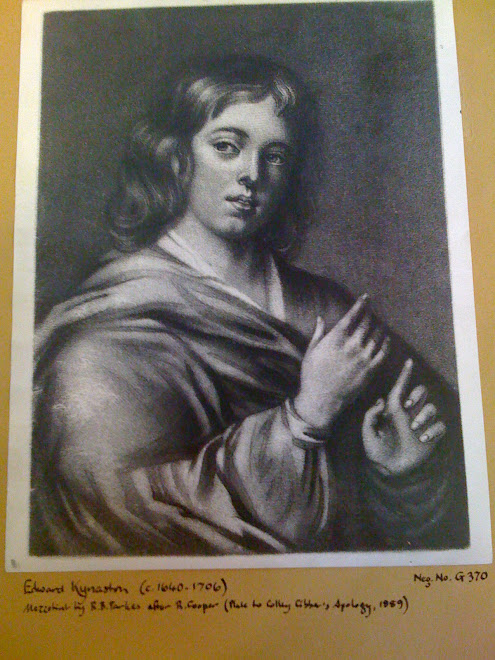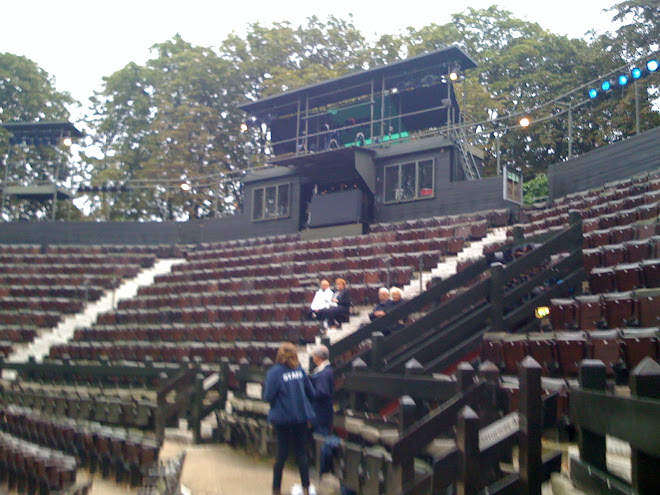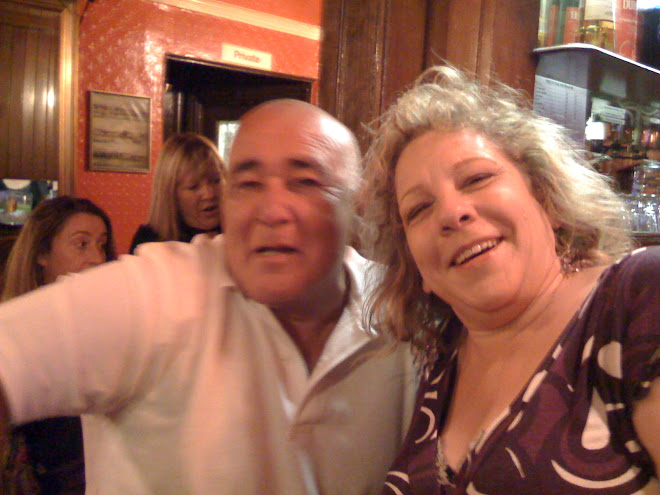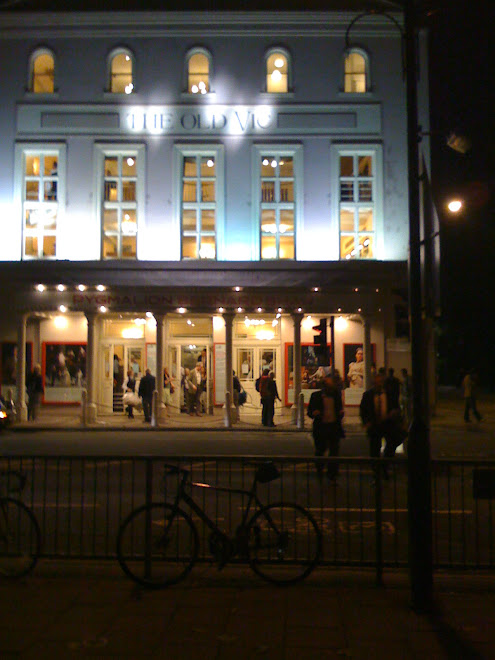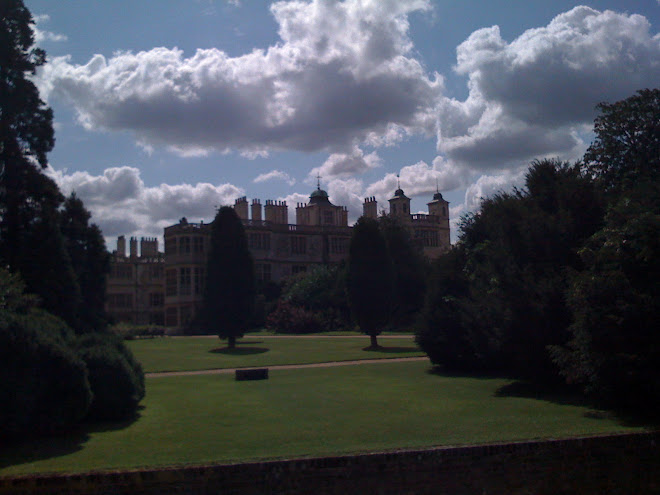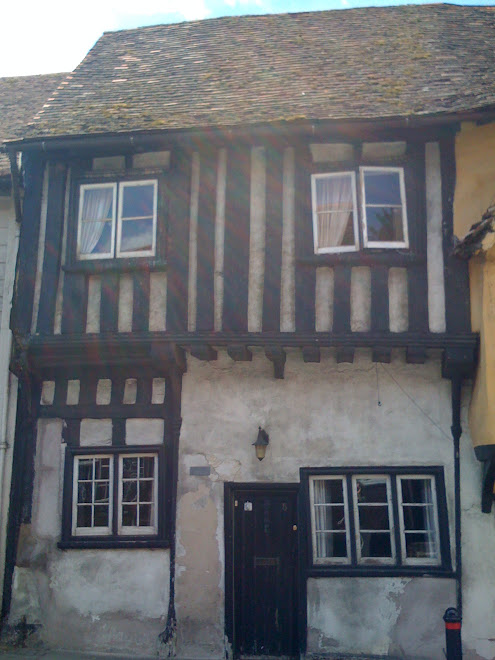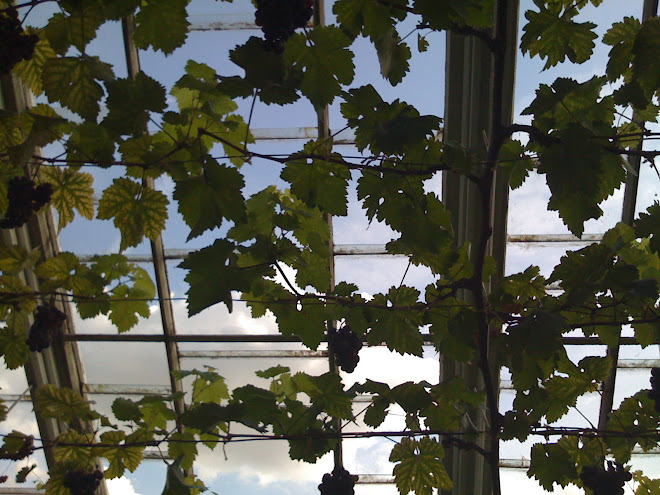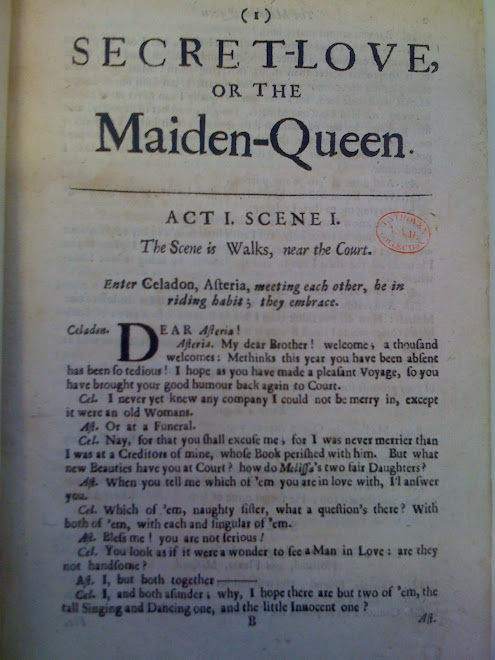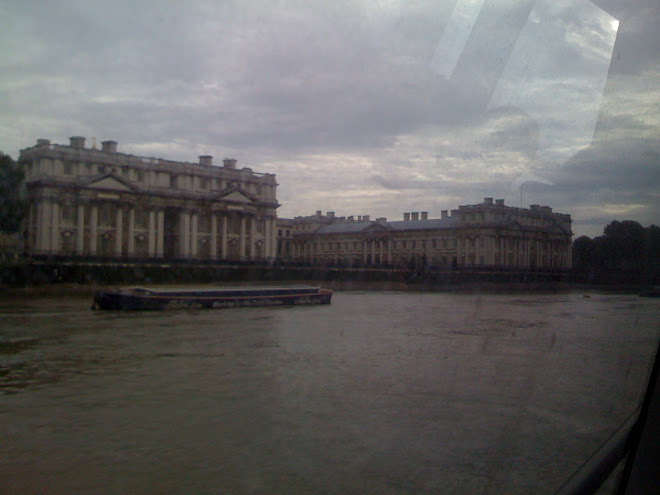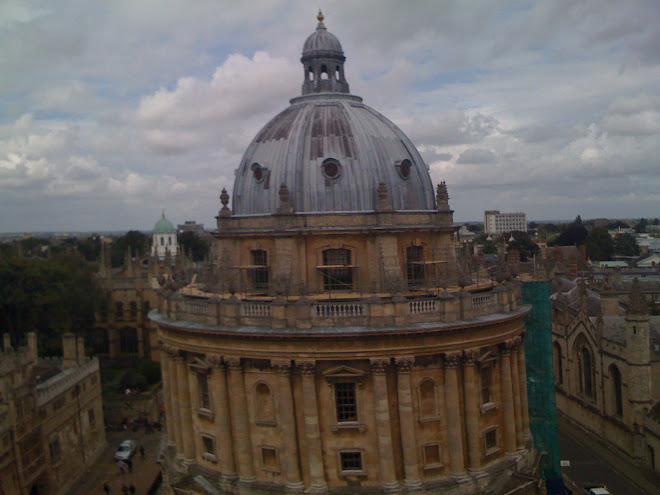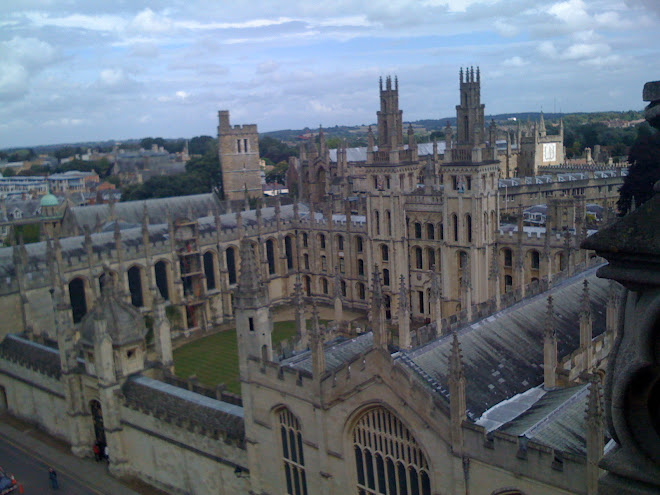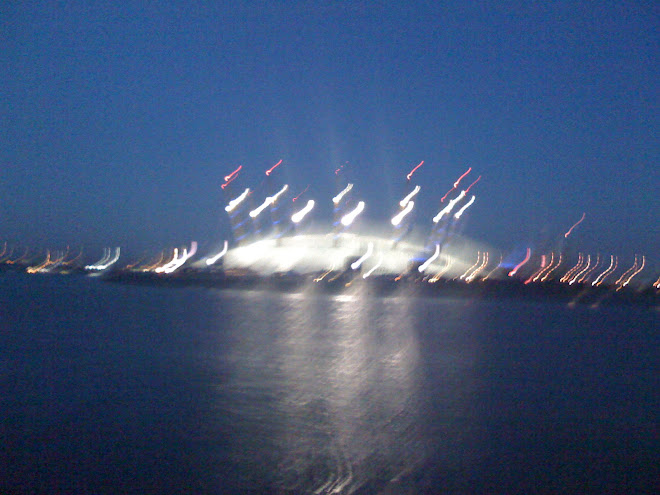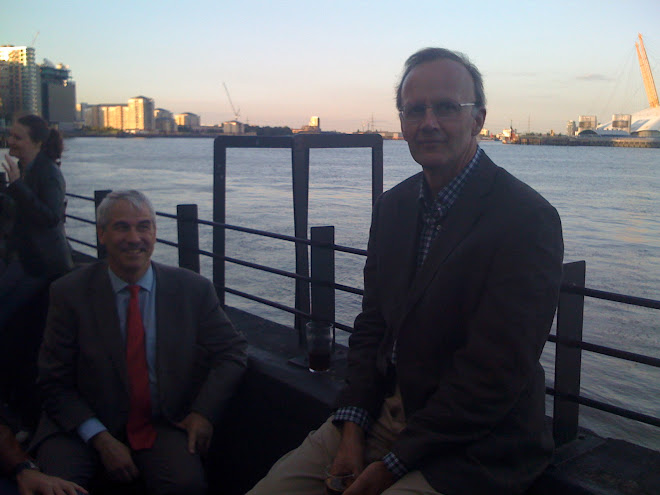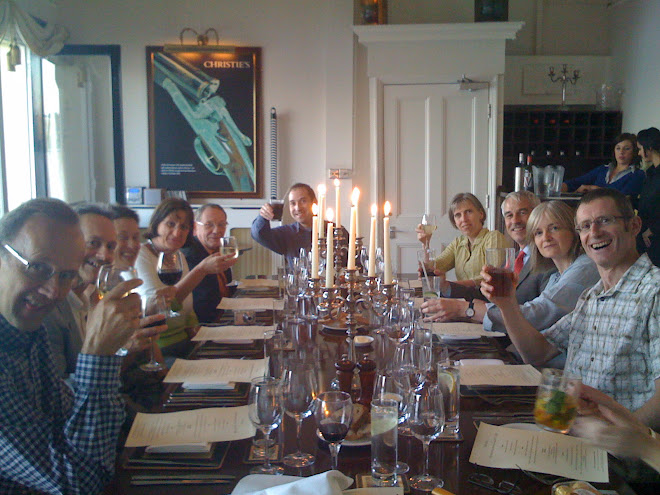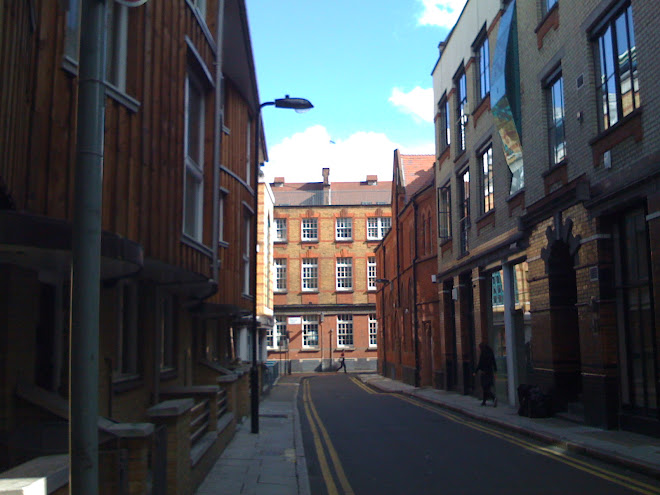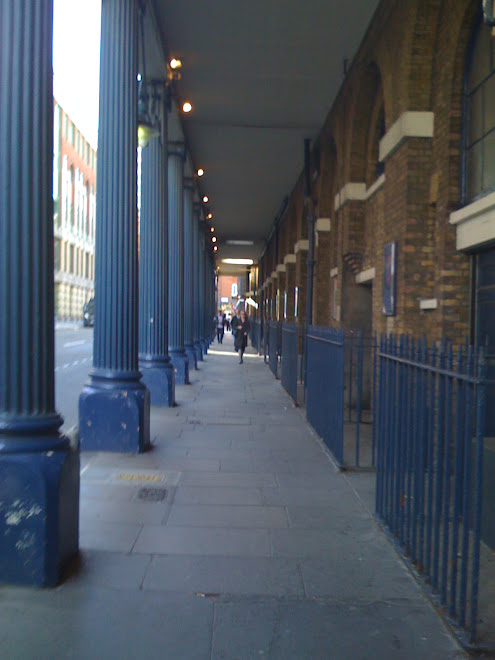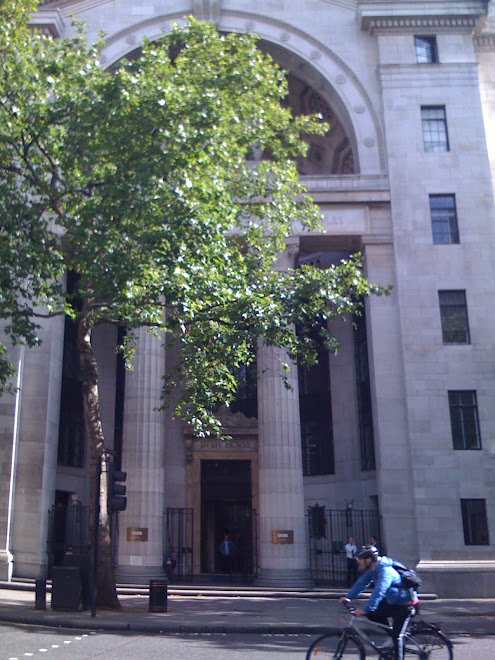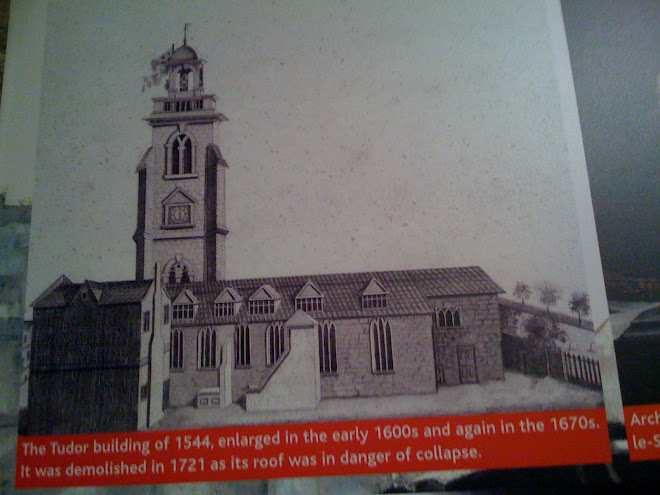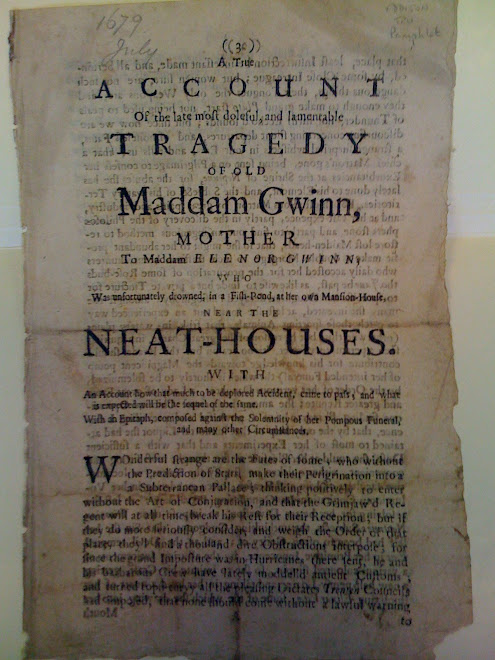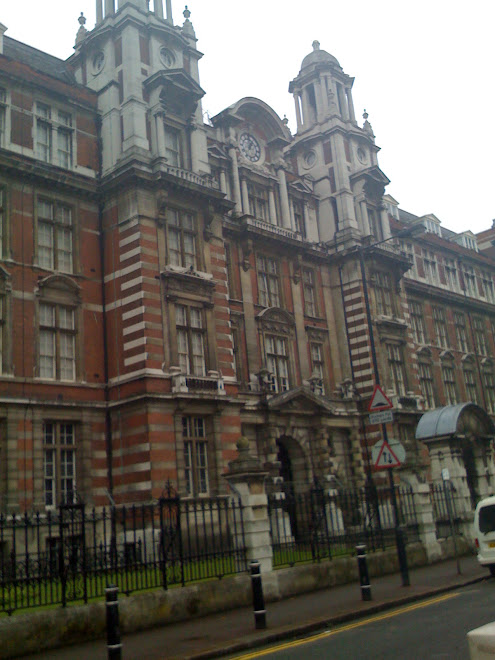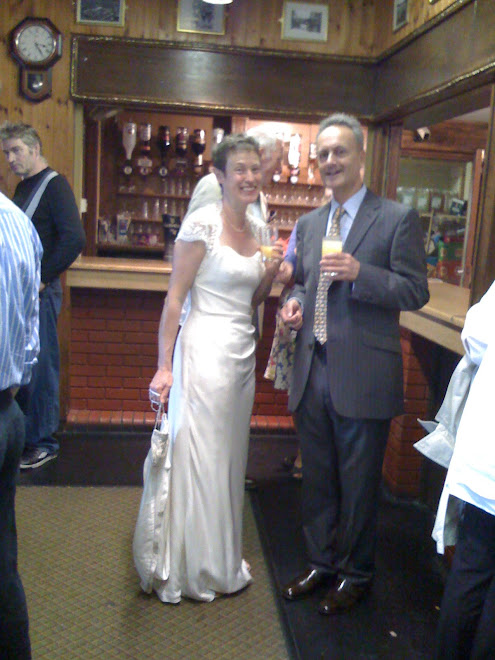Last night Jackie and I walked over to the Elephant Royale, right on the river and just behind where I used to live, and had lovely Thai dinner on the terrace. The view to Greenwich was lovely, in daylight, twilight, and dark.
Nell Gwynn almost certainly went to Greenwich. Charles II built an observatory there shortly after his restoration, which is still there, and still the location of the meridien from which Greenwich Mean Time originates. He also made improvements to the extensive royal park there.
There had been a palace at Greenwich for at least a couple of centuries. Henry VIII and Elizabeth I were born there, and it was there that Henry VIII signed the death warrant for Anne Boleyn. By the time of Charles II it was either gone or in poor repair, and he began building a new palace, but only got as far as one building, now referred to as the Charles II building, and part of what later became the Royal Naval College.
One of the stories as to how the Isle of Dogs got its name was that Henry VIII and other monarchs kept their hunting packs there.
Supposedly, Charles II was planning to grant Nell's wish to be ennobled and was planning to make her the Countess of Greenwich when he died, but alas, it never happened. I wonder if she really wanted it?
This morning I walked through the 1903 foot tunnel from this side of the river to Greenwich and spent a pleasant couple of hours at the little flea market and the covered market.
Sunday, August 31, 2008
Saturday, August 30, 2008
Around the island and walking with dinosaurs
Last Monday, which was a bank holiday here, Laura and her new husband David picked me up and we drove over to Crystal Palace Park, south of the river. The enormous glass, iron and wood structure that was built for the great Crystal Palace Exhibition in London in 1851 was later moved here, where it remained until it burned down in 1936. (For some pictures and information about the structure and exhibit, see http://www.st-andrews.ac.uk/~city19c/viccity/crystal1.html and http://en.wikipedia.org/wiki/The_Crystal_Palace).
Life-sized (well, maybe not quite life-sized, but big!) plaster replicas of dinosaurs were commissioned and were part of the exhibit, and they are still around the grounds of the park, along with models of more modern animals - elk, tapirs, etc. The palace was on a hill, and standing atop it you get sweeping views of the countryside to the south (the city falls away and greenery takes over pretty quickly once you're outside Greater London) and to the north, where you can see the City, with St. Paul's and the modern office building nicknamed The Gherkin.
Last night, my friends Tim, Alice, Alison and I met my friend Bucky outside the Canary Wharf station for a tour of the Island, dinner, and a visit to the local. Bucky runs the theatre program at the London branch of the American School in St. John's Wood, and spends more time around Americans than around Brits, and had been to the Isle of Dogs only a few times, and then only to Canary Wharf.
From the first years of the 19th century until the 1960's, the Isle of Dogs was home to London's major ports. When container shipping took hold, the docks gradually fell into disuse, leaving acres of derelict buildings and massive unemployment. In the early 1990s, an adventurous financier built Canada Tower, Britain's tallest building, hoping to create a new commerical center. At first it sat largely empty, but soon business took off. The publishing industry, long located at and sometimes simply referred to as "Fleet Street," moved to Canary Wharf, as did other businesses. Now there are many skyscrapers with housing Citibank, Barclay's, and other international corporations, with luxury flats and hotels. When I asked a cab driver to take me to the Isle of Dogs, he said, "Oh, the Isle of Money." But it's not all like that.
We walked to South Quay and then around the docks to near Millwall and the Mudchute DLR station, and then cut through Mudchute Farm and Millwall Park. Tim said that Mudchute is the largest farm inside a city. I think! There are allotments, or community garden plots, as well as sheep, cows, goats and other farm animals. The Mudchute is so named because when the second set of docks were being built in the mid-19th century, the excavated dirt was thrown up into a berm alongside the channel - and there it remains. It's a lovely oasis of green.
Donna met us at Memsaheb, my favorite Indian restaurant here, right on the river, and had a great meal, then walked along the river back to my old neighborhood. The Observatory in Greenwich projects a green laser beam along the meridien line, which shoots hot and bright in the dark above the river. We went for a drink at the Lord Nelson put, my old haunt. The Nelson's been there since about 1850, and for decades was a dockies' pub, catering to the dockworkers that were the Island's main population from about 1800 to 1900 or so.
The southwest quadrant of the Island, especially, still has a very neighborhoody feel, with many dockers' cottages that were built in the late 19th and early 20th centuries. The area along the river was heavily industrial from the second half of the 19th century, and was badly bombed during the World War II, with many civilian deaths. Now most of the river front has newer upscale flats. But in other places, there are still many people whose families have lived on the Island for years.
I really enjoyed living in this neighborhood when I was here for almost a year and a half two years ago caring for my mother. Since there are only two ways onto the Isle of Dogs by car (Blackwall Tunnel at the northeast and the Limehouse Link at the northwest), it's a lot more quiet and laid back than central London.
If you look at maps showing the Island up until the beginning of the 19th century, there isn't much there. A road around the perimeter, and one leading up the center of the horseshoe-shaped peninsula, with a ferry house at the foot of the island, near where the roads intersect, and a chapel house partway up the north-south middle road.
I lived where that north-south road, Eastferry Road, intersects the perimeter road, which is Westferry Road on the west and Manchester Road on the east. A couple hundred feet away, closer to the water, was the site of the ferry to Greenwich, which was there at least since the 14th century. Samuel Pepys got stuck there for a day, trying to get to a wedding south of the river. For all that time, there has always been a public house near the site, though the current Ferry House pub is only about 200 years old.
Life-sized (well, maybe not quite life-sized, but big!) plaster replicas of dinosaurs were commissioned and were part of the exhibit, and they are still around the grounds of the park, along with models of more modern animals - elk, tapirs, etc. The palace was on a hill, and standing atop it you get sweeping views of the countryside to the south (the city falls away and greenery takes over pretty quickly once you're outside Greater London) and to the north, where you can see the City, with St. Paul's and the modern office building nicknamed The Gherkin.
Last night, my friends Tim, Alice, Alison and I met my friend Bucky outside the Canary Wharf station for a tour of the Island, dinner, and a visit to the local. Bucky runs the theatre program at the London branch of the American School in St. John's Wood, and spends more time around Americans than around Brits, and had been to the Isle of Dogs only a few times, and then only to Canary Wharf.
From the first years of the 19th century until the 1960's, the Isle of Dogs was home to London's major ports. When container shipping took hold, the docks gradually fell into disuse, leaving acres of derelict buildings and massive unemployment. In the early 1990s, an adventurous financier built Canada Tower, Britain's tallest building, hoping to create a new commerical center. At first it sat largely empty, but soon business took off. The publishing industry, long located at and sometimes simply referred to as "Fleet Street," moved to Canary Wharf, as did other businesses. Now there are many skyscrapers with housing Citibank, Barclay's, and other international corporations, with luxury flats and hotels. When I asked a cab driver to take me to the Isle of Dogs, he said, "Oh, the Isle of Money." But it's not all like that.
We walked to South Quay and then around the docks to near Millwall and the Mudchute DLR station, and then cut through Mudchute Farm and Millwall Park. Tim said that Mudchute is the largest farm inside a city. I think! There are allotments, or community garden plots, as well as sheep, cows, goats and other farm animals. The Mudchute is so named because when the second set of docks were being built in the mid-19th century, the excavated dirt was thrown up into a berm alongside the channel - and there it remains. It's a lovely oasis of green.
Donna met us at Memsaheb, my favorite Indian restaurant here, right on the river, and had a great meal, then walked along the river back to my old neighborhood. The Observatory in Greenwich projects a green laser beam along the meridien line, which shoots hot and bright in the dark above the river. We went for a drink at the Lord Nelson put, my old haunt. The Nelson's been there since about 1850, and for decades was a dockies' pub, catering to the dockworkers that were the Island's main population from about 1800 to 1900 or so.
The southwest quadrant of the Island, especially, still has a very neighborhoody feel, with many dockers' cottages that were built in the late 19th and early 20th centuries. The area along the river was heavily industrial from the second half of the 19th century, and was badly bombed during the World War II, with many civilian deaths. Now most of the river front has newer upscale flats. But in other places, there are still many people whose families have lived on the Island for years.
I really enjoyed living in this neighborhood when I was here for almost a year and a half two years ago caring for my mother. Since there are only two ways onto the Isle of Dogs by car (Blackwall Tunnel at the northeast and the Limehouse Link at the northwest), it's a lot more quiet and laid back than central London.
If you look at maps showing the Island up until the beginning of the 19th century, there isn't much there. A road around the perimeter, and one leading up the center of the horseshoe-shaped peninsula, with a ferry house at the foot of the island, near where the roads intersect, and a chapel house partway up the north-south middle road.
I lived where that north-south road, Eastferry Road, intersects the perimeter road, which is Westferry Road on the west and Manchester Road on the east. A couple hundred feet away, closer to the water, was the site of the ferry to Greenwich, which was there at least since the 14th century. Samuel Pepys got stuck there for a day, trying to get to a wedding south of the river. For all that time, there has always been a public house near the site, though the current Ferry House pub is only about 200 years old.
Friday, August 29, 2008
Bits and pieces
First - photos. Someone told me that the feeds they are receiving of the blog don't have photos. You may have to go to the blog page itself to see photos. (http://nellgwynn.blogspot.com)
And I haven't yet found a way to make the photos appear beside the text, so they're all at the bottom!
Second -
I've had an inquiry or two about why no more frequent posts. Truth to tell, partly I wasn't sure if anyone was paying attention! Secondly, it takes longer than I would have thought to check my facts; find, post, and label photos, etc., and so it's easy to get behind. And finally, some of my time lately has been spent on pretty mundane things - doing a bit of money-work by email and dealing with having apparently dropped my wallet in the cab on the way home from the Gun last Friday! American Express and my credit union have now delivered replacement cards, so I'm back in business! And I'll try to be better about posting something every day or two.
Politics -
The BBC Parliament channel has been carrying the Democratic National Convention live, and replaying it throughout the following day, so I've been able to see most of the important speeches. I've had two of three friends ask me if I think Obama will win, to which I can only say I hope so! And that after this convention things look pretty good. He seems to be well-liked here, and even people who I would not have thought were paying attention have a favorable impression of him. Though at least one person was not entirely clear on the concept and thought it was already in the bag that he'd be the next president. That may be because the British are baffled by our endless election process. Here, the party that's in power decides when it feels like having a general election and holds it, a few weeks later. This seems an unfair advantage, but apparently it sometimes backfires.
Money -
Prices here in London are shockingly expensive. It seems even worse than when I was here before, or maybe it's just me. The papers recently carried stories that the cost of living here went up 4.4% in July. Food prices have gone up 11-19% since January. I'm glad I'm not driving - gas is about $10 a gallon. When I was here in 2005-2006 I was smoking (that's addiction - smoking while I watched my mother die of lung cancer, although hers was not smoking-related) and paying $10 every day for a pack of cigarettes. A week or so ago I noted that the price on the cigarette machine in the Lord Nelson was 6L - almost $12 - and pub machine packs only contain 16 cigarettes!
Virtually everything costs at least twice what I'd expect to pay at home, and some things (e.g., cosmetics and skin care, manicures and pedicures) cost three to four times what they do in California, so I do without if I can. If you go to Burger King or Starbucks, the prices are just about literally and exactly twice the U.S. prices. The smallest size of brewed coffee in Starbucks is 1.70L, and last time I bought one at home, it was $1.65.
The small blessing in all of this is that the dollar has actually gone up substantially against the pound just since I've been here. A 10L purchase the first couple days I was here deducted $19.60 from my bank account. The next 10L cost $19.20. The next $19.02. And yesterday I took 100L out of an ATM and it only cost me $183.61!
The weather -
That most British of subjects! Apparently it's the wettest August in Britain in 100 years. Not necessarily in London - it's rained here but not every day, but there has been flooding in other parts of the country. There have been days of sun and warmth and many other days of coolish weather, clouds, and rain or at least on and off drizzling. But a far cry from the 90 degree weather, and April-October summer in L.A.!
Slang -
While I was here before, I ended up compiling quite an extensive dictionary of London slang, and I'm picking up new examples all the time. Cockney rhyming slang is alive and well. How this works, in case you don't know, is that a word is referred to by a phrase that rhymes with it instead - or sometimes only part of the phrase. (Rhyming slang has been around for centuries, but probably not until after Nell's time.) Examples in regular current use are "on me tod" - Tod Sloane = own; take a butcher's - butcher's hook = look; cream-crackered = knackered (tired, wiped out); haven't got a Scooby - Scooby Doo = clue! An electrian friend told me that even Betty Grable (= cable) is still in use! Slap-headed means bald. WAGs means the Wives And Girlfriends of footballers (soccer players, that is). And speaking of footballers, the other day I heard someone refer to a couple of them "roasting" a woman - meaning to have group sex, and specifically two men and a woman, the derivation being apparently to spit-roast, or to roast something with a stake through it or something stuck in at each end. Ahem.
Traffic and improvements, gearing up for the Olympics:
Traffic in central London is appalling. I'm not driving, but a few times have been with friends as we try to get out of town to go somewhere else. There is a ring road of highway outside central London, but to get there you have to first work your way through a maze of streets that were never intended for car traffic. Much of the street layout remains the same as it was 800 years ago or more. Almost nothing is less than a couple of hundred years old. To try to alleviate the problem, the government has imposed a congestion charge. If you drive a car into or even through Central London, you have to pay a fee of 8L, or about $15 at current rate of exchange. If you don't pay it, you are automatically fined quite a lot. I think it's about $50 or $100. And you can't hide - you and your license plate are captured on CCTV and they will hunt you down and bill you.
Part of the gridlock has to do with many improvements to roads, the underground system, and other projects that are being done in anticipation of the 2012 Olympics. Much of the activity will take place in the East End, the part of London that is most in need of investment and infrastructure improvements, and the aim is that everything that is built will actually be useful afterwards.
All right. None of this has to do with Nell Gwynn especially. A lot has changed since her day. But much, I think, has not. In August 2008 as in 1650-1687, London is still a growing, bustling city, noisy and moving fast. Populated by immigrants as well as native-born English, and encompassing a range of social and economic conditions from dire poverty to fabulous wealth, frequently within a stone's throw of each other.
More people now have access to education and opportunity than they did even a few decades ago. When I was here a couple of years ago, a survey showed that a large percentage of people in executive and professional positions still considered themselves working class. That's because of their background, not their achievements. Accent still to some extent places people immediately on the social ladder. That's hard for Americans to really understand, I think. It works in my favor, though. Because my accent is different (yeah, I'm the one with the accent here, and people keep telling me they love the way I talk!) I can't be pegged into belonging to any particular class or background, so I can mix with all levels and backgrounds. I'm as out of place or as in place in an East End pub as I am among highly educated professionals.
One of the things that I find so interesting about Nell Gwynn's life, and which must have been hard for her sometimes, is that though she was born and grew up at the lowest level of poverty and hardship, she rose to live among royalty and nobility, and her sons were titled (the current Duke of St. Albans is descended, as his predecessors were, from the first Duke, Nell's oldest son Charles). But she could never be one of them. And she could never really go back to where she'd come from. She was neither fish nor foul. It must have been a lonely situation. Thank god for Rose, her sister, her lifelong friend.
And I haven't yet found a way to make the photos appear beside the text, so they're all at the bottom!
Second -
I've had an inquiry or two about why no more frequent posts. Truth to tell, partly I wasn't sure if anyone was paying attention! Secondly, it takes longer than I would have thought to check my facts; find, post, and label photos, etc., and so it's easy to get behind. And finally, some of my time lately has been spent on pretty mundane things - doing a bit of money-work by email and dealing with having apparently dropped my wallet in the cab on the way home from the Gun last Friday! American Express and my credit union have now delivered replacement cards, so I'm back in business! And I'll try to be better about posting something every day or two.
Politics -
The BBC Parliament channel has been carrying the Democratic National Convention live, and replaying it throughout the following day, so I've been able to see most of the important speeches. I've had two of three friends ask me if I think Obama will win, to which I can only say I hope so! And that after this convention things look pretty good. He seems to be well-liked here, and even people who I would not have thought were paying attention have a favorable impression of him. Though at least one person was not entirely clear on the concept and thought it was already in the bag that he'd be the next president. That may be because the British are baffled by our endless election process. Here, the party that's in power decides when it feels like having a general election and holds it, a few weeks later. This seems an unfair advantage, but apparently it sometimes backfires.
Money -
Prices here in London are shockingly expensive. It seems even worse than when I was here before, or maybe it's just me. The papers recently carried stories that the cost of living here went up 4.4% in July. Food prices have gone up 11-19% since January. I'm glad I'm not driving - gas is about $10 a gallon. When I was here in 2005-2006 I was smoking (that's addiction - smoking while I watched my mother die of lung cancer, although hers was not smoking-related) and paying $10 every day for a pack of cigarettes. A week or so ago I noted that the price on the cigarette machine in the Lord Nelson was 6L - almost $12 - and pub machine packs only contain 16 cigarettes!
Virtually everything costs at least twice what I'd expect to pay at home, and some things (e.g., cosmetics and skin care, manicures and pedicures) cost three to four times what they do in California, so I do without if I can. If you go to Burger King or Starbucks, the prices are just about literally and exactly twice the U.S. prices. The smallest size of brewed coffee in Starbucks is 1.70L, and last time I bought one at home, it was $1.65.
The small blessing in all of this is that the dollar has actually gone up substantially against the pound just since I've been here. A 10L purchase the first couple days I was here deducted $19.60 from my bank account. The next 10L cost $19.20. The next $19.02. And yesterday I took 100L out of an ATM and it only cost me $183.61!
The weather -
That most British of subjects! Apparently it's the wettest August in Britain in 100 years. Not necessarily in London - it's rained here but not every day, but there has been flooding in other parts of the country. There have been days of sun and warmth and many other days of coolish weather, clouds, and rain or at least on and off drizzling. But a far cry from the 90 degree weather, and April-October summer in L.A.!
Slang -
While I was here before, I ended up compiling quite an extensive dictionary of London slang, and I'm picking up new examples all the time. Cockney rhyming slang is alive and well. How this works, in case you don't know, is that a word is referred to by a phrase that rhymes with it instead - or sometimes only part of the phrase. (Rhyming slang has been around for centuries, but probably not until after Nell's time.) Examples in regular current use are "on me tod" - Tod Sloane = own; take a butcher's - butcher's hook = look; cream-crackered = knackered (tired, wiped out); haven't got a Scooby - Scooby Doo = clue! An electrian friend told me that even Betty Grable (= cable) is still in use! Slap-headed means bald. WAGs means the Wives And Girlfriends of footballers (soccer players, that is). And speaking of footballers, the other day I heard someone refer to a couple of them "roasting" a woman - meaning to have group sex, and specifically two men and a woman, the derivation being apparently to spit-roast, or to roast something with a stake through it or something stuck in at each end. Ahem.
Traffic and improvements, gearing up for the Olympics:
Traffic in central London is appalling. I'm not driving, but a few times have been with friends as we try to get out of town to go somewhere else. There is a ring road of highway outside central London, but to get there you have to first work your way through a maze of streets that were never intended for car traffic. Much of the street layout remains the same as it was 800 years ago or more. Almost nothing is less than a couple of hundred years old. To try to alleviate the problem, the government has imposed a congestion charge. If you drive a car into or even through Central London, you have to pay a fee of 8L, or about $15 at current rate of exchange. If you don't pay it, you are automatically fined quite a lot. I think it's about $50 or $100. And you can't hide - you and your license plate are captured on CCTV and they will hunt you down and bill you.
Part of the gridlock has to do with many improvements to roads, the underground system, and other projects that are being done in anticipation of the 2012 Olympics. Much of the activity will take place in the East End, the part of London that is most in need of investment and infrastructure improvements, and the aim is that everything that is built will actually be useful afterwards.
All right. None of this has to do with Nell Gwynn especially. A lot has changed since her day. But much, I think, has not. In August 2008 as in 1650-1687, London is still a growing, bustling city, noisy and moving fast. Populated by immigrants as well as native-born English, and encompassing a range of social and economic conditions from dire poverty to fabulous wealth, frequently within a stone's throw of each other.
More people now have access to education and opportunity than they did even a few decades ago. When I was here a couple of years ago, a survey showed that a large percentage of people in executive and professional positions still considered themselves working class. That's because of their background, not their achievements. Accent still to some extent places people immediately on the social ladder. That's hard for Americans to really understand, I think. It works in my favor, though. Because my accent is different (yeah, I'm the one with the accent here, and people keep telling me they love the way I talk!) I can't be pegged into belonging to any particular class or background, so I can mix with all levels and backgrounds. I'm as out of place or as in place in an East End pub as I am among highly educated professionals.
One of the things that I find so interesting about Nell Gwynn's life, and which must have been hard for her sometimes, is that though she was born and grew up at the lowest level of poverty and hardship, she rose to live among royalty and nobility, and her sons were titled (the current Duke of St. Albans is descended, as his predecessors were, from the first Duke, Nell's oldest son Charles). But she could never be one of them. And she could never really go back to where she'd come from. She was neither fish nor foul. It must have been a lonely situation. Thank god for Rose, her sister, her lifelong friend.
Wednesday, August 27, 2008
Still behind in blogging....
Somehow it is difficult to keep up the blogging with all I've been doing. So rather that put nothing, I'll post a quick rundown of the last week or so, and then post more details and photos later.
On Friday, August 15, Jackie and her friend Laura and I had a long but lovely day trip to Saffron Walden and then to Audley End, both in Essex. Saffron Walden is a charming market town, with many buildings surviving from the 16th and 17th centuries or even earlier,and gave a feel for what a town of the 17th century would have been like. Among other buildings of interest is an inn that Cromwell used as his headquarters at one point during the Civil War.
Audley End is a stately home that Charles II bought in 1667, though he rarely used it, and it ceased to be a royal palace around the end of the 17th century. I don't know if Nell was ever there, but she could have been. Some of the house remains as it would have been when Charles owned it, some has alterations from the 18th and 19th century. The lovely extensive grounds include both lush lawns with a meandering river, and large gardens that are actively cultivated, and include many heirloom varieties of fruit. The house has a very nice living history component, with actors in Victorian costumes assuming the characters of servants from that era and working in the kitchens and other service areas.
After Audley End, we repaired to The Cricketers, the gastro pub/restaurant in Clavering, Essex, owned by the parents of renowned British chef Jamie Oliver. There were no reservations available for dinner, so we settled for a drink outside, enjoying the waning sunlight of the warm summer evening. And then to dinner at the Old King's Head in Chigwell, also in Essex. Parts of the place date from the 16th century, and Charles Dickens stayed at the inn while writing "Barnaby Rudge."
On Wednesday, August 20, Jackie and I went to Oxford, which was certainly a place that Nell knew. She may very well have gone there with the theatre company when they and the court left London to escape from the plague in 1665 (and in my book she does so). She certainly was there later. It was in Oxford during the turmoil over the Papist Plot that a crowd began to pelt or rock Nell's carriage, mistaking her for Charles's hated French mistress, Louise de Keroualle. Nell popped her head out and cried, "Pray, good people, be civil. I am the Protestant whore!"
The main streets of Oxford were a thousand years old when Nell was there, and of course much of the university dates from the 13th to 16th centuries. We stood on Folly Bridge, overlooking the river, the very site of the original "oxen ford" that gives the city its name.
My book includes a scene set in a park in Oxford in 1665, and I decided that University Park, north of the central area of town, which has been used as a pleasure garden at least since the 17th century, seemed suitable. Jackie and I took an enjoyable walk through the green grass and huge spreading trees, and along the banks of the Cherwell, where ducks swam. I was pleased to read later that it is a matter of record that Charles II did use to walk there with his spaniels.
The court was at Oxford during the plague, but Oxford was also the Royalist headquarters during the Civil War, and a place that Charles returned to several times during his reign.
Friday, August 22, was dinner at the Gun, a 200-year old pub at the northeast of the Isle of Dogs which is now a highly regarded and popular gastro pub. My Uncle Al had graciously invited me to host a dinner to thank the friends, neighbors, and colleagues who had done so much to help my mother during her last year or two, and to help me during my long and difficult time here. A great meal! If there hadn't been several vegetarians, I would have opted to order the "feast menu," with a whole roast suckling pig! When else will I ever get the chance? We had our own room on the second floor (or the first floor, in British terminology), looking right out over the water to what was formerly the Millenium Dome and is now the O2, a major performance venue with a collection of shops, restaurants, and bars.
I've also spent two more afternoons in the V&A archives at Kensington Olympia, going through materials related to theatre, which were formerly held in the Covent Garden Theatre Museum, now sadly defunct. I looked through the biographical files on playwright Aphra Behn, who was a friend of Nell's and dedicated a play to her; actress Elizabeth Barry, another friend, who specialized in tragedy while Nell excelled in comedy; and actors John Lacy, Edward Kynaston, and William Cartwright.
The V&A theatre archives also holds a copy of the catalogue for an exhibition of the dozens of paintings that Cartwright owned, including one of Charles II, and a catalogue for an exhibit about Nell Gwynn that was held at the Geffrye Museum in London in the 70s.
There are copies of the original designs for the scenery for the 1661 production of "The Siege of Rhodes" by William Davenant's Duke's Company in Lincoln's Inn Fields - the first production in England to use moving scenery.
It was incredibly exciting to hold in my hand the actual 1669 script of "Secret Love," the play that made Nell a star! And intriguing to read the 1658 "An Apology for Actors," purportedy written by Thomas Heywood, but probably actually written by William Cartwright, an actor who had been a member of the King's Company before Cromwell closed the theatres. He made his living as a bookseller during the interregnum, and was one of the principal members of the company when it was reestablished in 1660. He appeared in many plays that Nell was also in over the years, and she surely knew him well.
Last Saturday Jackie took her mother (and Jackie's boyfriend and me) to a wonderful lunch and then to the Donmar Warehouse's production of "Piaf," with Elena Roger giving a truly phenomenal performance in the title role. She's Argentinian, and got great reviews as Evita here last year. Remember her name; you'll be hearing a lot more about her!
Another night last week I had dinner with friend Alice at Booty's (yes! Booty's!), a pub on the riverfront in Limehouse, in the East End and not far from the Isle of Dogs. It's an area that in centuries past was full of sailors and other maritime-related folks and activities. Like prostitution. Now it's becoming more upscale. Sir Ian McKellan even lives there! And I think Helen Mirren is also in the area. As Alice and I ate, we watched a little platoon of sailboats carrying out maneuvers in the light rain on the choppy water. The Union Jack outside the window flapped wetly and furled itself around its flagpole, but eventually sprang free and waved proudly once more.
Of course London has been in an Olympics frenzy over the past couple of weeks, joyous but slightly stunned at their successful performance, and gearing up the handoff - the 2012 Olympics will be held at various venues right here in the East End. I was here on July 6, 2005, when London got the news that it had gotten the 2012 Olympics. I felt like a Londoner, happy that "we" had gotten it, and shaken the next day, with the subway bombings. One of my friends told me that it's said it takes three years for someone to consider themself a Londoner. I don't know - I'm part way there!
On Friday, August 15, Jackie and her friend Laura and I had a long but lovely day trip to Saffron Walden and then to Audley End, both in Essex. Saffron Walden is a charming market town, with many buildings surviving from the 16th and 17th centuries or even earlier,and gave a feel for what a town of the 17th century would have been like. Among other buildings of interest is an inn that Cromwell used as his headquarters at one point during the Civil War.
Audley End is a stately home that Charles II bought in 1667, though he rarely used it, and it ceased to be a royal palace around the end of the 17th century. I don't know if Nell was ever there, but she could have been. Some of the house remains as it would have been when Charles owned it, some has alterations from the 18th and 19th century. The lovely extensive grounds include both lush lawns with a meandering river, and large gardens that are actively cultivated, and include many heirloom varieties of fruit. The house has a very nice living history component, with actors in Victorian costumes assuming the characters of servants from that era and working in the kitchens and other service areas.
After Audley End, we repaired to The Cricketers, the gastro pub/restaurant in Clavering, Essex, owned by the parents of renowned British chef Jamie Oliver. There were no reservations available for dinner, so we settled for a drink outside, enjoying the waning sunlight of the warm summer evening. And then to dinner at the Old King's Head in Chigwell, also in Essex. Parts of the place date from the 16th century, and Charles Dickens stayed at the inn while writing "Barnaby Rudge."
On Wednesday, August 20, Jackie and I went to Oxford, which was certainly a place that Nell knew. She may very well have gone there with the theatre company when they and the court left London to escape from the plague in 1665 (and in my book she does so). She certainly was there later. It was in Oxford during the turmoil over the Papist Plot that a crowd began to pelt or rock Nell's carriage, mistaking her for Charles's hated French mistress, Louise de Keroualle. Nell popped her head out and cried, "Pray, good people, be civil. I am the Protestant whore!"
The main streets of Oxford were a thousand years old when Nell was there, and of course much of the university dates from the 13th to 16th centuries. We stood on Folly Bridge, overlooking the river, the very site of the original "oxen ford" that gives the city its name.
My book includes a scene set in a park in Oxford in 1665, and I decided that University Park, north of the central area of town, which has been used as a pleasure garden at least since the 17th century, seemed suitable. Jackie and I took an enjoyable walk through the green grass and huge spreading trees, and along the banks of the Cherwell, where ducks swam. I was pleased to read later that it is a matter of record that Charles II did use to walk there with his spaniels.
The court was at Oxford during the plague, but Oxford was also the Royalist headquarters during the Civil War, and a place that Charles returned to several times during his reign.
Friday, August 22, was dinner at the Gun, a 200-year old pub at the northeast of the Isle of Dogs which is now a highly regarded and popular gastro pub. My Uncle Al had graciously invited me to host a dinner to thank the friends, neighbors, and colleagues who had done so much to help my mother during her last year or two, and to help me during my long and difficult time here. A great meal! If there hadn't been several vegetarians, I would have opted to order the "feast menu," with a whole roast suckling pig! When else will I ever get the chance? We had our own room on the second floor (or the first floor, in British terminology), looking right out over the water to what was formerly the Millenium Dome and is now the O2, a major performance venue with a collection of shops, restaurants, and bars.
I've also spent two more afternoons in the V&A archives at Kensington Olympia, going through materials related to theatre, which were formerly held in the Covent Garden Theatre Museum, now sadly defunct. I looked through the biographical files on playwright Aphra Behn, who was a friend of Nell's and dedicated a play to her; actress Elizabeth Barry, another friend, who specialized in tragedy while Nell excelled in comedy; and actors John Lacy, Edward Kynaston, and William Cartwright.
The V&A theatre archives also holds a copy of the catalogue for an exhibition of the dozens of paintings that Cartwright owned, including one of Charles II, and a catalogue for an exhibit about Nell Gwynn that was held at the Geffrye Museum in London in the 70s.
There are copies of the original designs for the scenery for the 1661 production of "The Siege of Rhodes" by William Davenant's Duke's Company in Lincoln's Inn Fields - the first production in England to use moving scenery.
It was incredibly exciting to hold in my hand the actual 1669 script of "Secret Love," the play that made Nell a star! And intriguing to read the 1658 "An Apology for Actors," purportedy written by Thomas Heywood, but probably actually written by William Cartwright, an actor who had been a member of the King's Company before Cromwell closed the theatres. He made his living as a bookseller during the interregnum, and was one of the principal members of the company when it was reestablished in 1660. He appeared in many plays that Nell was also in over the years, and she surely knew him well.
Last Saturday Jackie took her mother (and Jackie's boyfriend and me) to a wonderful lunch and then to the Donmar Warehouse's production of "Piaf," with Elena Roger giving a truly phenomenal performance in the title role. She's Argentinian, and got great reviews as Evita here last year. Remember her name; you'll be hearing a lot more about her!
Another night last week I had dinner with friend Alice at Booty's (yes! Booty's!), a pub on the riverfront in Limehouse, in the East End and not far from the Isle of Dogs. It's an area that in centuries past was full of sailors and other maritime-related folks and activities. Like prostitution. Now it's becoming more upscale. Sir Ian McKellan even lives there! And I think Helen Mirren is also in the area. As Alice and I ate, we watched a little platoon of sailboats carrying out maneuvers in the light rain on the choppy water. The Union Jack outside the window flapped wetly and furled itself around its flagpole, but eventually sprang free and waved proudly once more.
Of course London has been in an Olympics frenzy over the past couple of weeks, joyous but slightly stunned at their successful performance, and gearing up the handoff - the 2012 Olympics will be held at various venues right here in the East End. I was here on July 6, 2005, when London got the news that it had gotten the 2012 Olympics. I felt like a Londoner, happy that "we" had gotten it, and shaken the next day, with the subway bombings. One of my friends told me that it's said it takes three years for someone to consider themself a Londoner. I don't know - I'm part way there!
Sunday, August 17, 2008
Playing catch up!
I've fallen behind in my writing, but not in my activities!
Last Tuesday I had planned to go to the British Library but got a late start so I decided to do some walking in Nell's foosteps instead.
She lived and worked up, down, and around Drury Lane at various times. so I started there. I got off the underground at Tottenham Court Road, walked down Charing Cross Road (taking pictures of what should be 84 Tottenham Court Road, as in charming the book of that title, chronicling the correspondence over about 20 years between an American writer and the staff of an English bookshop).
Somehow I missed the turn onto St. Giles High Street, so I walked on Shaftesbury Avenue and over on High Holborn to the north end of Drury Lane and then down, stopping to take pictures as I went.
There is a pub called the White Hart at 191 Drury Lane, just south of High Holborn, and according to The London Encyclopedia, there has been a pub by that name on that site since the 15th century, so Nell would certainly have known it, if not frequented it.
The first street south of High Holborn on the east side of Drury Lane is now Stukely Street, but according to Morgan's Map of the Whole of London in 1682 (accessible at British History Online, www.british-history.ac.uk) it was previously The Cole Yard, or Coal Yard, one of the places sometimes mentioned ss Nell's birthplace (along with other places near Covent Garden or sometimes Oxfordshire).
The next street south, now Macklin Street, was formerly Lewkenor's Lane, the site of Madam Ross's brothel, where Nell's sister Rose worked -- and where Nell did, too, at least in my book!
Though the area is much changed, and no buildings from the 17th century remain, both Stukely Street and Macklin Street are very short - only a block or two, and narrow, and probably not much changed in their footprint since Nell's time.
From Lewkenor's Lane/Macklin Street, it's only about a five minute walk to the Theatre Royal, where Nell first worked as an orange girl and later as an actress. The original theatre, which opened on May 7, 1663, was much smaller than the present one, and according to The London Stage 1660-1700 and other sources, was built on a plot of ground only 112 feet long by 58 feet wide. It was between Drury Lane to the northeast, Bridges Street (now Catherine Street) to the southwest, and Russell Street to the northwest, was set back from the street and behind other buildings, and was reached by passageways from the streets. Contemporary maps that show the site include Lacy's 1673 map of the parish of St. Paul, Covent Garden, and Morgan and Ogilby's map of London, 1681-82. I believe both are at the British Library, and hope to be able to see the originals and get good copies!
Nell's Theatre Royal burned down, along with the company's stock of costumes and scenery and several adjacent houses, and killing an actor named Bell, on January 25, 1672, after Nell had stopped acting, and a new theatre, designed by Christopher Wren, opened on the site in 1674.
Nell also lived at the Cat and Fiddle and Cock and Pie taverns, both near the site of the Theatre Royal. Samuel Pepys saw her standing at the door of her lodgings on May 1, 1667 in her smock sleeves and bodice (not quite completely dressed, that is), watching milkmaids with garlands on their pails dancing to the music of a fiddler.
The Cock and Pie was near the top of Maypole Alley, which led from Drury Lane to the Strand. It's long gone, and the whole area much changed from Nell's time, but Maypole Alley seems to have run through the area where Aldwych is now, probably just west of Kingsway. It came out in the Strand near St. Mary le Strand, near the present location of Bush House, the home of the BBC. Maypole Alley was named for the 134-foot maypole that was erected in front of the church for May Day, 1661, by a party of twelve sailors under the direction of James, the Duke of York, who was head of the navy.
The opening chapter of my book follows Nell on May 29, 1660, the day on which Charles II rode into London to reclaim his throne. I have her walking from the Strand to Whitehall to get another glimpse of the King, so I followed her path down the Strand and to the Banqueting House in Whitehall, the only remaining part of the palace of Whitehall, which burned down in 1698. I'll walk in and write more about that area later, because Nell spent a lot of time there!
I concluded my day's rambles by heading to the church of St. Martin in the Fields, at Trafalgar Square. This was Nell's parish church for much of her life. She gave her mother a lavish funeral there when she died in 1679, which was the last occasion on which her "Merry Gang" of court wits was together. Nell's funeral was also held at St. Martin in the Fields, and the service given by Thomas Tenison, later Archbishop of Canterbury. The Tudor-era church that Nell knew was demolished in 1721 because its roof was in danger of collapse, and the present church dates from 1726.
Nell was buried in the crypt of St. Martin in the Fields, where there is now rather a nice cafe. Several years ago when I asked about the location of her grave, cafe staff said they thought it might be under the ovens! I've read more recently that Nell's might have been among graves moved during renovations at some point.
Well -- I haven't nearly caught up with what I've done in the past week, but I'm giving up for now, and resolve to write more regularly!
Last Tuesday I had planned to go to the British Library but got a late start so I decided to do some walking in Nell's foosteps instead.
She lived and worked up, down, and around Drury Lane at various times. so I started there. I got off the underground at Tottenham Court Road, walked down Charing Cross Road (taking pictures of what should be 84 Tottenham Court Road, as in charming the book of that title, chronicling the correspondence over about 20 years between an American writer and the staff of an English bookshop).
Somehow I missed the turn onto St. Giles High Street, so I walked on Shaftesbury Avenue and over on High Holborn to the north end of Drury Lane and then down, stopping to take pictures as I went.
There is a pub called the White Hart at 191 Drury Lane, just south of High Holborn, and according to The London Encyclopedia, there has been a pub by that name on that site since the 15th century, so Nell would certainly have known it, if not frequented it.
The first street south of High Holborn on the east side of Drury Lane is now Stukely Street, but according to Morgan's Map of the Whole of London in 1682 (accessible at British History Online, www.british-history.ac.uk) it was previously The Cole Yard, or Coal Yard, one of the places sometimes mentioned ss Nell's birthplace (along with other places near Covent Garden or sometimes Oxfordshire).
The next street south, now Macklin Street, was formerly Lewkenor's Lane, the site of Madam Ross's brothel, where Nell's sister Rose worked -- and where Nell did, too, at least in my book!
Though the area is much changed, and no buildings from the 17th century remain, both Stukely Street and Macklin Street are very short - only a block or two, and narrow, and probably not much changed in their footprint since Nell's time.
From Lewkenor's Lane/Macklin Street, it's only about a five minute walk to the Theatre Royal, where Nell first worked as an orange girl and later as an actress. The original theatre, which opened on May 7, 1663, was much smaller than the present one, and according to The London Stage 1660-1700 and other sources, was built on a plot of ground only 112 feet long by 58 feet wide. It was between Drury Lane to the northeast, Bridges Street (now Catherine Street) to the southwest, and Russell Street to the northwest, was set back from the street and behind other buildings, and was reached by passageways from the streets. Contemporary maps that show the site include Lacy's 1673 map of the parish of St. Paul, Covent Garden, and Morgan and Ogilby's map of London, 1681-82. I believe both are at the British Library, and hope to be able to see the originals and get good copies!
Nell's Theatre Royal burned down, along with the company's stock of costumes and scenery and several adjacent houses, and killing an actor named Bell, on January 25, 1672, after Nell had stopped acting, and a new theatre, designed by Christopher Wren, opened on the site in 1674.
Nell also lived at the Cat and Fiddle and Cock and Pie taverns, both near the site of the Theatre Royal. Samuel Pepys saw her standing at the door of her lodgings on May 1, 1667 in her smock sleeves and bodice (not quite completely dressed, that is), watching milkmaids with garlands on their pails dancing to the music of a fiddler.
The Cock and Pie was near the top of Maypole Alley, which led from Drury Lane to the Strand. It's long gone, and the whole area much changed from Nell's time, but Maypole Alley seems to have run through the area where Aldwych is now, probably just west of Kingsway. It came out in the Strand near St. Mary le Strand, near the present location of Bush House, the home of the BBC. Maypole Alley was named for the 134-foot maypole that was erected in front of the church for May Day, 1661, by a party of twelve sailors under the direction of James, the Duke of York, who was head of the navy.
The opening chapter of my book follows Nell on May 29, 1660, the day on which Charles II rode into London to reclaim his throne. I have her walking from the Strand to Whitehall to get another glimpse of the King, so I followed her path down the Strand and to the Banqueting House in Whitehall, the only remaining part of the palace of Whitehall, which burned down in 1698. I'll walk in and write more about that area later, because Nell spent a lot of time there!
I concluded my day's rambles by heading to the church of St. Martin in the Fields, at Trafalgar Square. This was Nell's parish church for much of her life. She gave her mother a lavish funeral there when she died in 1679, which was the last occasion on which her "Merry Gang" of court wits was together. Nell's funeral was also held at St. Martin in the Fields, and the service given by Thomas Tenison, later Archbishop of Canterbury. The Tudor-era church that Nell knew was demolished in 1721 because its roof was in danger of collapse, and the present church dates from 1726.
Nell was buried in the crypt of St. Martin in the Fields, where there is now rather a nice cafe. Several years ago when I asked about the location of her grave, cafe staff said they thought it might be under the ovens! I've read more recently that Nell's might have been among graves moved during renovations at some point.
Well -- I haven't nearly caught up with what I've done in the past week, but I'm giving up for now, and resolve to write more regularly!
Tuesday, August 12, 2008
A few days on....
I haven't been able to get internet access as consistently as I'd hoped, but now I'm back on the Island (Isle of Dogs, that is), I can always come down to my old haunt the Lord Nelson pub and use the wireless connection!
Last Wednesday I spent a second afternoon in the archives of the V&A on Blythe Road. Found pictures of Nell's houses on Pall Mall and in Windsor, pictures of some of her contemporary actors and other theatre people - Edward Kynaston (who briefly played women's roles after the Restoration), William Cartwright, Michael Mohun, and John Lacy (all old-timers who'd been actors before Cromwell closed the theatres in 1642) and playwright John Dryden.
Also had the opportunity to see (and photograph - thanks, iPhone!) the original 1669 script of "Secret Love," the play that made a star of Nell. She and her lover Charles Hart, the leading actor of the King's Company, played opposite each other as a pair of sparring, witty lovers, somewhat in the Beatrice and Benedick vein, who of course get together in the end but set out the contract under which they'll have a freewheeling and happy relationship despite being married!
The days since have been a blitz of theatre, as well as getting a bit of writing done.
Thursday night I went with Alice, Alison, and Donna to the Natioal to see "Never So Good," a new play about prime minister Harold Macmillan starring Jeremey Irons. It covered the 30s to 60s, but especially the 50s and 60s, a period of British history that I didn't know much about.
Friday was "Pygmalion" at the Old Vic, directed by Peter Hall, also very good. Saturday afternoon saw my friend Cathy Owen in "This Wide Night" at the Soho Theatre, a very intense drama about two women who were cell mates in prison reuniting after being released. Both Cathy and the other actress were great! I hadn't seen Cathy on stage before and it was great to do so.
Last night went with Donna to the Regent's Park Open Air Theatre to see "Gigi", fun and charming of course.
Now back to more Nell research! Off to the British Library to register for a reader's card and hunt out some period maps to help me pinpoint the location of Nell's houses and other haunts.
Last Wednesday I spent a second afternoon in the archives of the V&A on Blythe Road. Found pictures of Nell's houses on Pall Mall and in Windsor, pictures of some of her contemporary actors and other theatre people - Edward Kynaston (who briefly played women's roles after the Restoration), William Cartwright, Michael Mohun, and John Lacy (all old-timers who'd been actors before Cromwell closed the theatres in 1642) and playwright John Dryden.
Also had the opportunity to see (and photograph - thanks, iPhone!) the original 1669 script of "Secret Love," the play that made a star of Nell. She and her lover Charles Hart, the leading actor of the King's Company, played opposite each other as a pair of sparring, witty lovers, somewhat in the Beatrice and Benedick vein, who of course get together in the end but set out the contract under which they'll have a freewheeling and happy relationship despite being married!
The days since have been a blitz of theatre, as well as getting a bit of writing done.
Thursday night I went with Alice, Alison, and Donna to the Natioal to see "Never So Good," a new play about prime minister Harold Macmillan starring Jeremey Irons. It covered the 30s to 60s, but especially the 50s and 60s, a period of British history that I didn't know much about.
Friday was "Pygmalion" at the Old Vic, directed by Peter Hall, also very good. Saturday afternoon saw my friend Cathy Owen in "This Wide Night" at the Soho Theatre, a very intense drama about two women who were cell mates in prison reuniting after being released. Both Cathy and the other actress were great! I hadn't seen Cathy on stage before and it was great to do so.
Last night went with Donna to the Regent's Park Open Air Theatre to see "Gigi", fun and charming of course.
Now back to more Nell research! Off to the British Library to register for a reader's card and hunt out some period maps to help me pinpoint the location of Nell's houses and other haunts.
Wednesday, August 6, 2008
Hitting the ground running....
Ack! I've only been here a few days and already behind on my writing!
I arrived Saturday afternoon and my friend Donna took me back to her place in Brockley. A nap, a bit of curry with her and Alison, and to bed.
Sunday afternoon was the wedding bash of our dear friend Laura and her new husband David - they got married in a civil service on July 17. They're both professional musicians, so Laura's Big Band played - and she sat in on the sax for a few numbers - photo attached (I hope!)
It was a case of being plunged immediately into my past life here - in some ways I can't believe I've been gone two years, in others it feels like I've never left. The wedding reception was at Calder's Wharf Community Center, right near the entrance to the Greenwich foot tunnel on the Isle of Dogs side, just down the street from the building where I lived for almost a year and a half, my old local the Lord Nelson pub, the 1903 firehouse that ceased to function as a firehouse while I was there and has since been converted to flats, and around the corner from the homes of Laura, Tim, Clare, Si, Cath...
Monday was a day to get organized - get my UK cell phone up and running, etc. In the evening, I went with Alice and Tim to the National Theatre and saw a really fantastic production of Middleton's (or was it Turner?) "Revenger's Tragedy." More or less modern dress, but somewhat stylized, with swords and daggers. Great set - turntable in the center - divided by scrims and passages into three crescent-shaped scenes - painted with lurid and classical scenes. Lots of intense and explicit sex and violence, as befits the show. Very good actors pretty much all around. (www.nationaltheatre.org.uk)
Yesterday (Tuesday), I had my first research appointment at the Victoria & Albert Museum (www.vam.ac.uk) -- actually, at their archives at Kensington Olympia. They had already gotten out for me the biographical files on Nell Gwynn and her friend and fellow actor John Lacey. Went through those and then the box on Drury Lane Theatre for the period 1663-1674. They mostly contained newspaper clipppings, copies of portraits, and anything remotely related to Nell Gwynn -- for instance 1920's cigarette cards or ads depicting her as a flapper orange wench!
I didn't really learn anything new, but did find some pictures of Nell's home at 79 Pall Mall and the one in Windsor, and it was very interesting to see what they had. And there is a wealth of other documents, book, etc., which I'll have a look at today.
Perhaps the most exciting thing to see was an original 4-page pamphlet from 1679, rather a cruel satire on the death of Nell's mother, who drowned, probably drunk, in a ditch or fish pond. I knew of it and had read excerpts, but holding the actual thing in my hand was something else...
The archives lets you photocopy items more recent than 1932. Anything else you can only take photos. So I was very pleased to find that my new iPhone takes such great pictures -- and allows you to zoom in closely enough -- that the pictures I took of this pamphlet are actually completely legible!
I arrived Saturday afternoon and my friend Donna took me back to her place in Brockley. A nap, a bit of curry with her and Alison, and to bed.
Sunday afternoon was the wedding bash of our dear friend Laura and her new husband David - they got married in a civil service on July 17. They're both professional musicians, so Laura's Big Band played - and she sat in on the sax for a few numbers - photo attached (I hope!)
It was a case of being plunged immediately into my past life here - in some ways I can't believe I've been gone two years, in others it feels like I've never left. The wedding reception was at Calder's Wharf Community Center, right near the entrance to the Greenwich foot tunnel on the Isle of Dogs side, just down the street from the building where I lived for almost a year and a half, my old local the Lord Nelson pub, the 1903 firehouse that ceased to function as a firehouse while I was there and has since been converted to flats, and around the corner from the homes of Laura, Tim, Clare, Si, Cath...
Monday was a day to get organized - get my UK cell phone up and running, etc. In the evening, I went with Alice and Tim to the National Theatre and saw a really fantastic production of Middleton's (or was it Turner?) "Revenger's Tragedy." More or less modern dress, but somewhat stylized, with swords and daggers. Great set - turntable in the center - divided by scrims and passages into three crescent-shaped scenes - painted with lurid and classical scenes. Lots of intense and explicit sex and violence, as befits the show. Very good actors pretty much all around. (www.nationaltheatre.org.uk)
Yesterday (Tuesday), I had my first research appointment at the Victoria & Albert Museum (www.vam.ac.uk) -- actually, at their archives at Kensington Olympia. They had already gotten out for me the biographical files on Nell Gwynn and her friend and fellow actor John Lacey. Went through those and then the box on Drury Lane Theatre for the period 1663-1674. They mostly contained newspaper clipppings, copies of portraits, and anything remotely related to Nell Gwynn -- for instance 1920's cigarette cards or ads depicting her as a flapper orange wench!
I didn't really learn anything new, but did find some pictures of Nell's home at 79 Pall Mall and the one in Windsor, and it was very interesting to see what they had. And there is a wealth of other documents, book, etc., which I'll have a look at today.
Perhaps the most exciting thing to see was an original 4-page pamphlet from 1679, rather a cruel satire on the death of Nell's mother, who drowned, probably drunk, in a ditch or fish pond. I knew of it and had read excerpts, but holding the actual thing in my hand was something else...
The archives lets you photocopy items more recent than 1932. Anything else you can only take photos. So I was very pleased to find that my new iPhone takes such great pictures -- and allows you to zoom in closely enough -- that the pictures I took of this pamphlet are actually completely legible!
Subscribe to:
Comments (Atom)


